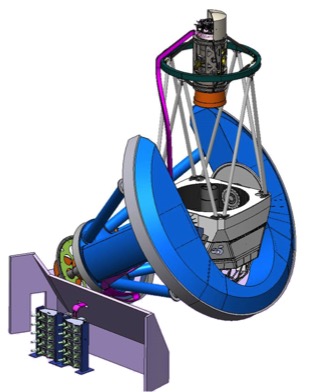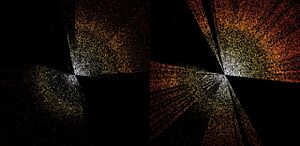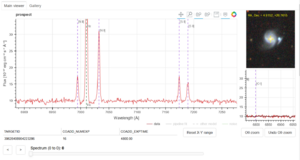Dark Energy Spectroscopic Instrument facts for kids

DESI design concept in February, 2016
|
|
| Alternative names | DESI |
|---|---|
| Part of | Kitt Peak National Observatory Nicholas U. Mayall Telescope |
| Location(s) | Kitt Peak, Arizona |
| Coordinates | 31°57′30″N 111°35′48″W / 31.9583°N 111.5967°W |
| Organization | Lawrence Berkeley National Laboratory |
| Altitude | 2,100 m (6,900 ft) |
| Wavelength | 360 nm (830 THz)–980 nm (310 THz) |
| Built | 2015– |
| First light | 2019 |
| Telescope style | scientific instrument spectrometer |
| Website | desi |
| |
|
The Dark Energy Spectroscopic Instrument (DESI) is a special tool used by scientists to study faraway galaxies. It helps them create huge maps of the universe. DESI's main goal is to understand dark energy, a mysterious force that makes the universe expand faster and faster.
DESI started its main survey in May 2021. It is located on top of Kitt Peak in Arizona, USA. This mountain is about 2,100 meters (6,900 feet) high. DESI is attached to the Mayall Telescope there.
Many groups helped build and fund DESI. The Lawrence Berkeley National Laboratory leads the project. Funding came from the US Department of Energy, the US National Science Foundation, and other countries like the UK, France, Mexico, and Spain.
Contents
What Does DESI Study?
DESI helps scientists learn about the expansion of the universe. It also studies the biggest patterns of matter in space. By doing this, DESI can help us understand dark energy. It might also tell us if Einstein's theory of gravity needs changes on a cosmic scale.
The data from DESI will create detailed 3D maps of the universe. These maps will show how galaxies are spread out. This helps scientists figure out what dark energy is. It also helps them understand how the universe grew in its early days.
Baryon Acoustic Oscillations
DESI uses a method called baryon acoustic oscillations (BAO). This method helps measure how fast the universe is expanding. BAO looks at patterns in how galaxies are grouped together. These patterns are like "sound waves" from the early universe.
By measuring these patterns, scientists can figure out distances in space. This is a very reliable way to study dark energy. The BAO method helps scientists avoid many errors in their data.
Mapping the Universe in 3D

To use the BAO method, scientists need a 3D map of distant galaxies. DESI creates this map by looking at the light from galaxies. When light from a galaxy travels through space, it stretches. This stretching is called redshift.
By measuring the redshift, scientists can tell how far away a galaxy is. This allows them to build a 3D map of the universe. This map also gives clues about the mass of tiny particles called neutrinos. It also helps us learn about the very first moments of the universe.
DESI started its five-year survey on May 15, 2021. It plans to observe 40 million galaxies and quasars. This will be the biggest 3D map of the universe ever made!
How DESI Works
DESI is a very advanced instrument. It has a special lens system that gives it a wide view of the sky. This system weighs about 10,000 kilograms (10 tonnes). It also has 5,000 tiny robots that move optical fibers.
These robots can quickly point the fibers at different galaxies. This allows DESI to collect light from 5,000 objects at once. The light then travels through long cables to special cameras called spectrographs. These spectrographs break the light into different colors. This helps scientists learn about the objects.
The whole system can be set up for a new view in less than two minutes. This means DESI can observe many galaxies very quickly. The Lawrence Berkeley National Laboratory manages the building and operation of DESI. Over 600 scientists from around the world work together on this project.
DESI Legacy Imaging Surveys
Before DESI could start its main work, scientists needed to know where to point it. So, three other telescopes worked together to create the DESI Legacy Imaging Surveys. These surveys took pictures of a large part of the sky.
They used different colors of light (g, r, and z-band) to find galaxies and quasars. These surveys covered about one-third of the entire sky. They avoided areas blocked by our own Milky Way galaxy.
The Legacy Surveys found 1.6 billion objects. These objects include galaxies and quasars that are up to 11 billion years old. You can even see colored images from these surveys online using the Legacy Survey Sky Browser.
DESI's Journey So Far
Scientists started planning DESI in December 2012. The Lawrence Berkeley National Laboratory was chosen to lead the project. Building the new instrument began in June 2016.
The first light from the new lens system was seen on April 1, 2019. The full instrument saw its first light on October 22, 2019. DESI was finished ahead of schedule and under budget in March 2020. This earned the project an award.
After a short break due to the pandemic, DESI started its main five-year survey on May 14, 2021. In the summer of 2022, a large fire called the Contreras fire happened near Kitt Peak. DESI was not damaged and is still working normally.
DESI Data Releases
Scientists share the information collected by DESI with others. This is done through "data releases." You can find all the public data from DESI online at data.desi.lbl.gov. This includes catalogs of galaxies and other useful information.
There are also easier ways to look at the data. For example, you can use the legacy viewer online. You can click on a galaxy or star to see its spectrum. A spectrum shows the different colors of light from an object.
Early Data Release
On June 13, 2023, DESI announced its Early Data Release (EDR). This release included spectra from almost two million galaxies, quasars, and stars. One exciting discovery from the EDR was announced in February 2023. It showed a huge movement of stars into the Andromeda Galaxy. The EDR also found very distant quasars and stars with very low metal content.




